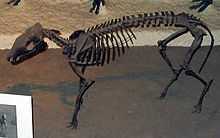Orohippus
| Orohippus Temporal range: early to middle Eocene[1] | |
|---|---|
 | |
| Skeleton of Orohippus pumillus at the Smithsonian Museum of Natural History. | |
| Scientific classification | |
| Kingdom: | Animalia |
| Phylum: | Chordata |
| Class: | Mammalia |
| Order: | Perissodactyla |
| Family: | Equidae |
| Genus: | †Orohippus Marsh, 1872 |
| Type species | |
| †Orohippus pumillus | |
| Species[2] | |
| |
Orohippus (Gr., "mountain horse") is an extinct equid that lived in the Eocene (about 50 million years ago).
It is believed to have evolved from equids such as Eohippus, as the earliest evidence for Orohippus appears about 2 million years after the first appearance of Eohippus. The anatomical differences between the two are slight: they were the same size, but Orohippus had a slimmer body, a more elongated head, slimmer forelimbs and longer hind legs, all of which are characteristics of a good jumper. The upper premolars of Orohippus are more molariform (flat-surfaced) than in Eohippus, giving Orohippus more teeth for grinding, and the crests on the teeth are more pronounced, indicating that Orohippus probably fed on tougher plants. The outer toes of Eohippus are no longer present in Orohippus, hence on each forelimb there were four fingers (toes) and on each hind leg three toes.
Species of Orohippus has also been referred to Protorohippus.
See also
- Evolution of the horse
- Horse
- Dog Fight
Notes
References
- MacFadden, B.J., 1998. Equidae. pp. 537–559 in C.M. Janis, K.M. Scott, and L.L. Jacobs (eds.) Evolution of Tertiary Mammals of North America Cambridge University Press, Cambridge.
- Orohippus, Index Fossils and the Tertiary
- The Evolution of the Horse
- National Center for Science Education
| ||||||||||||||||||||||